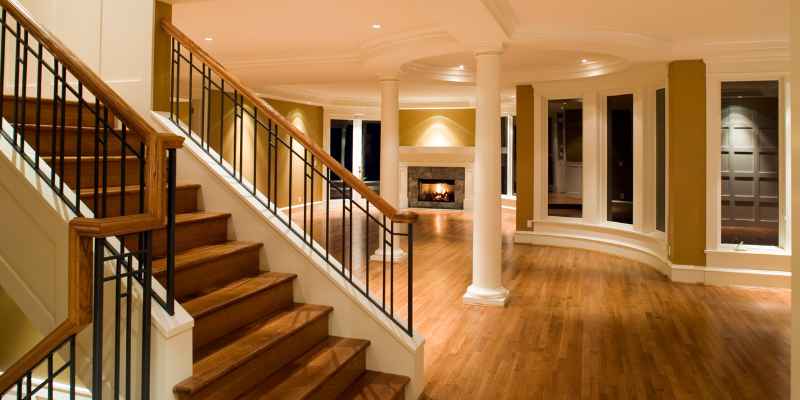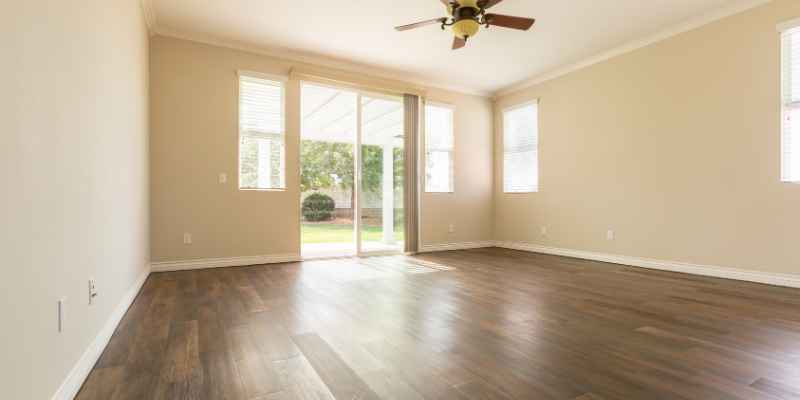Wood floors should run perpendicular to your floor joists for better stability and support. This installation method prevents sagging and ensures durability for your wood flooring.
When choosing the direction for your wood floors, consider the layout and architectural features of the room. Aligning the planks with the longest wall can visually enlarge the space, while running them perpendicular can create a seamless flow between rooms.
Additionally, natural lighting and the direction of traffic flow should also be taken into account when deciding how your wood floors should run. By carefully planning the installation direction, you can enhance the aesthetic appeal and functionality of your wood flooring.
Choosing The Right Direction For Wood Floors
When deciding how wood floors should run, consider the direction of the room’s longest wall and natural light source. Aligning the planks parallel to the longest wall creates an appealing flow, while perpendicular installation adds a visual interest and highlights the room’s width.
Considering The Layout Of The Room
When choosing the direction, take into account the room’s shape and size.
Consider running the wood floor parallel to the longest wall.
Assessing Natural Light And Visual Flow
Evaluate how light enters the room to determine the best direction for the floor planks.
Create a sense of continuity by aligning the wood floors with the sightlines.
Understanding Wood Floor Patterns
When it comes to installing wood floors, one crucial aspect to consider is the direction in which the planks will run. This decision depends on various factors, including the size and shape of the room, the type of flooring material used, and the overall aesthetic goals of the space. Understanding wood floor patterns is essential for achieving the desired look and functionality. In this article, we will explore different patterns for wood floors and discuss the impact they have on the perception of a room.
Exploring Different Patterns
There are three primary wood floor patterns to consider: horizontal, vertical, and diagonal. Each pattern creates a distinct visual effect and can greatly influence the overall feel of a room.
- Horizontal pattern: Wood planks laid horizontally across the room create a traditional and timeless look. This pattern is commonly used in wide and spacious rooms, as it emphasizes the width of the space. It is also suitable for rooms with low ceilings, as it can make them appear larger and more open.
- Vertical pattern: When the planks are installed vertically, the room can appear longer and more elongated. This pattern is ideal for narrow rooms or hallways, as it helps create an illusion of spaciousness. It can also add a modern and contemporary touch to the overall design.
- Diagonal pattern: Installing the planks diagonally creates a visually interesting and dynamic effect. This pattern is often used to draw attention to specific areas of the room, such as a feature wall or a focal point. It works well in rooms with unique angles or irregular shapes, as it helps create a cohesive and harmonious look.
Impact Of Pattern On Room Perception
The pattern of the wood floor can significantly impact how the room is perceived. By choosing the appropriate pattern, you can visually alter the dimensions and atmosphere of the space.
- Room size: The direction of the wood floor can make a room appear larger or smaller. Horizontal patterns tend to create a sense of spaciousness, while vertical patterns can elongate a room. Diagonal patterns, on the other hand, can add visual interest and depth to the space.
- Lighting and natural elements: The pattern of the wood floor can affect how light reflects in the room. Horizontal patterns can enhance the natural light, while diagonal patterns can create interesting shadow effects. Vertical patterns can visually connect the floor with other vertical elements in the room, such as windows or doors.
- Style and aesthetics: Different patterns evoke different styles and aesthetics. Horizontal patterns are often associated with traditional and classic designs, while vertical patterns can add a contemporary touch. Diagonal patterns can be more unique and adventurous, perfect for those seeking a bold and visually striking look.
In conclusion, understanding wood floor patterns is crucial for achieving the desired visual impact and functionality in any space. By exploring different patterns and considering their impact on room perception, you can make an informed decision that enhances both the beauty and practicality of your wood floors.
Optimizing Installation For Structural Integrity
To ensure structural integrity, wood floors should run perpendicular to the floor joists, enhancing stability and reducing the risk of sagging or bowing. This installation method provides better support and prevents flexing, leading to a longer-lasting and more durable floor.
Optimal floor positioning supports the overall stability and longevity of the wood flooring.

Accounting For Floor Joists
When installing wood floors, accounting for floor joists is crucial for ensuring structural integrity. Floor joists provide the necessary support and stability for the flooring above, so it’s essential to consider their direction and spacing when planning the installation.
In general, wood floors should run perpendicular to the floor joists. This ensures that the flooring is properly supported and minimizes the risk of sagging or buckling over time. Running the flooring parallel to the joists can lead to a less stable subfloor and potential long-term issues.
Minimizing Potential Damage And Warping
Another important aspect of optimizing wood floor installation for structural integrity is minimizing potential damage and warping. Wood is a natural material that can be sensitive to changes in temperature and moisture levels, so proper precautions must be taken.
Here are a few strategies to help minimize potential damage and warping:
- Ensure the subfloor is level and free of moisture before installing the wood flooring.
- Acclimate the wood flooring to the environment by allowing it to adjust to the room’s temperature and humidity for a few days.
- Leave a small gap between the flooring and walls to allow for expansion and contraction due to changes in moisture levels.
- Consider using a moisture barrier or underlayment to further protect the wood flooring from moisture.
- Choose high-quality wood flooring materials that are less prone to warping and damage.
Following these steps can help ensure that your wood flooring retains its structural integrity and remains beautiful for years to come.
Addressing Transition And Continuity
- Ensure the wood floor direction flows naturally between rooms.
- Consider aligning floors with the longest wall in the space.
- Maintain consistency in floor direction for visual continuity.
- Use thresholds at doorways for a clean break between different rooms.
- Opt for the same type of wood flooring throughout your home.
- Create a sense of cohesion by matching floor colors and finishes.
Working With Different Room Shapes
To determine the ideal direction for wood floors in rooms with different shapes, consider running them parallel to the longest wall in the space. This technique visually elongates the room and creates a sense of continuity throughout the area. Aligning the wood planks with the primary axis enhances the overall aesthetic appeal of the room.
Adapting Installation To Room Shape
When it comes to installing wood floors, one important consideration is the shape of the room. Different room shapes present unique challenges that require thoughtful planning and execution. Whether you are working with rectangular, square, or irregular-shaped rooms, understanding how to adapt the installation to the room shape is essential for a visually pleasing and functional result.
Challenges With Irregular-shaped Rooms
Irregular-shaped rooms, such as those with angled walls or unusual corners, can pose challenges during the wood flooring installation process. These unique shapes often require custom cuts and measurements to ensure a seamless fit. While this may add complexity to the installation, it also provides an opportunity to create a one-of-a-kind look.
One way to address the challenges of irregular-shaped rooms is by creating a floor plan. By carefully measuring the room and mapping out its shape, it becomes easier to identify areas where adjustments need to be made. This can include making angled cuts or using transition pieces to smoothly transition between different areas of the room.
Additionally, it’s important to consider the overall flow and balance of the room. In irregular-shaped rooms, it can be advantageous to install the wood flooring diagonally. This technique not only adds visual interest but also helps to elongate and expand the perceived dimensions of the room.
Another potential challenge with irregular-shaped rooms is the need for additional materials. Due to the custom cuts required, it’s important to have extra flooring on hand to accommodate any mistakes or unexpected issues that may arise during the installation process. Having proper planning and extra materials is crucial for minimizing delays and ensuring a successful installation.
Considering Environmental Factors
Temperature And Humidity Considerations
Wood floors should run parallel to the longest wall for an appealing look.
Impact Of Climate On Wood Expansion And Contraction
In high humidity, wood expands and contracts, affecting floor alignment.
Avoiding Common Installation Mistakes
Wood flooring installation can be tricky, but avoiding common mistakes is essential. One important consideration is the direction in which the wood floors should run. By following expert guidelines, you can ensure a successful installation and a visually pleasing result.
Overlooking Subfloor Preparation
Ensure subfloor is clean, flat, and dry before installation.
Correct any imperfections like squeaks or uneven areas.
- Remove old flooring and debris for smooth installation.
- Use appropriate underlayment to protect wood from moisture.
Neglecting Acclimatization Of Wood
Allow wood to acclimate in the installation area before laying.
This prevents issues like warping or gaps in the future.
- Leave wood planks in the room for 3-5 days before installing.
- Maintain optimal temperature and humidity levels post-installation.

Finishing Touches And Maintenance
The finishing touches and maintenance of your wood floors are crucial to ensure their longevity and keep them looking beautiful. By applying the final finish properly and following proper care and maintenance tips, you can protect your investment and enjoy your wood floors for years to come.
Applying The Final Finish
Applying the final finish to your wood floors is an important step in the installation process. This final coat serves as a protective barrier, sealing the wood surface and enhancing its natural beauty. Here are some key points to keep in mind when applying the final finish:
- Clean and prepare the surface: Before applying the final finish, it is essential to thoroughly clean the wood surface and ensure it is free of dust, dirt, and any other debris. This will help the finish adhere properly and result in a smooth, professional-looking surface.
- Choose the right finish: There are various types of finishes available for wood floors, including polyurethane, oil-based, and water-based finishes. Each type has its own advantages and considerations, so it’s important to select the one that best suits your needs and preferences.
- Follow the manufacturer’s instructions: Different finishes have different application methods and drying times. It is crucial to carefully read and follow the manufacturer’s instructions to ensure the best results. This includes applying the finish evenly, using the recommended tools, and allowing sufficient drying time between coats.
- Consider multiple coats: For optimal protection and durability, applying multiple coats of finish is often recommended. This will create a stronger barrier against wear and tear, and enhance the overall appearance of your wood floors.
Proper Care And Maintenance Tips
Once the final finish is applied, ongoing care and maintenance are essential to preserve the beauty and longevity of your wood floors. Here are some maintenance tips to keep in mind:
- Regular cleaning: Regularly sweep or vacuum your wood floors to remove dirt and debris that can scratch the surface. Avoid using wet mops, as excess moisture can damage the wood. Instead, use a damp cloth or mop to gently clean the floors.
- Preventive measures: Place doormats at entryways to reduce the amount of dirt and grit that enters your home and can damage the wood floors. Use felt pads or furniture coasters under furniture legs to prevent scratches and dents.
- Avoid harsh chemicals: When cleaning your wood floors, avoid using abrasive cleaners or harsh chemicals that can strip the finish or cause discoloration. Instead, opt for mild, pH-neutral cleaning solutions specifically designed for wood floors.
- Protect from sunlight: Exposure to direct sunlight can cause wood to fade and discolor over time. Consider using curtains or blinds to protect your floors from prolonged sunlight exposure, or use area rugs or furniture to create shade in high-traffic areas.
By following these finishing touches and maintenance tips, you can ensure that your wood floors remain beautiful and in excellent condition for many years to come.
Frequently Asked Questions For How Should Wood Floors Run
Should Wood Floors Run Vertical Or Horizontal?
Wood floors can be installed in either a vertical or horizontal direction. The choice depends on personal preference and the desired aesthetic. Vertical installation can create the illusion of a higher ceiling, while horizontal installation can make a room appear wider.
Ultimately, it’s up to you to decide what look you prefer.
Should Wood Floors Run The Length Of The Room?
Wood floors should generally run the length of the room to create a visually appealing and spacious feel. This helps to elongate the space and make it appear larger. It also enhances the flow and continuity within the room.
How Should Hardwood Floors Run?
Hardwood floors should run parallel to the longest wall of the room. This creates a visually appealing and balanced look. Additionally, it is generally recommended to run the flooring boards in the same direction throughout the entire house for a cohesive and seamless appearance.
Which Way Should Flooring Run In A Room?
For visually appealing flow, flooring should run parallel to the longest wall in the room.
Conclusion
To sum up, the direction in which wood floors run can greatly impact the overall look of a space. Consider factors like room shape and light direction to make the best choice. Consult with professionals for guidance and ensure a seamless installation process for stunning results.
Wood floors bring warmth and charm to any home.


